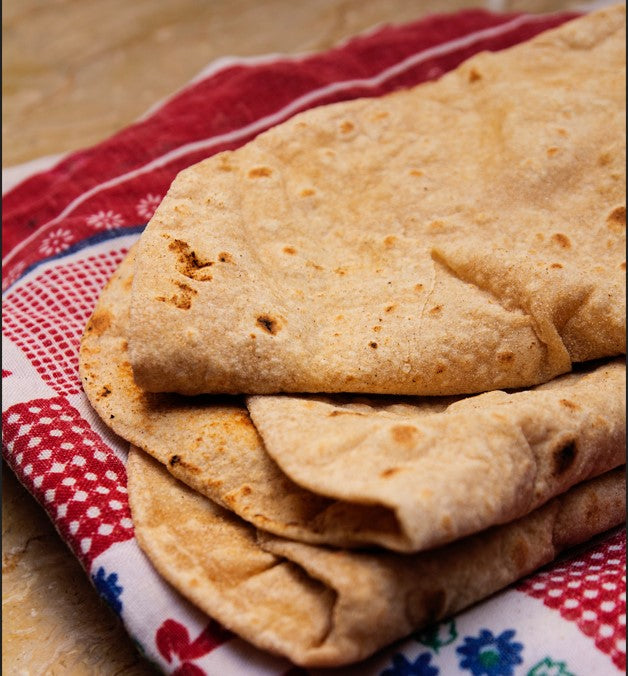Naan, Paratha, Roti and Chapati
What is a naan bread?
One of the most common questions we get asked at the shop is ‘is a roti a naan bread’, or some variation thereof. While there are some similarities in the function and basic construction of the breads, they do have some distinct differences.
A naan bread, or just naan, is a thick, baked bread made of wheat and all-purpose flour, also known as maida. Naans were baked in tandoor ovens, and can be served plain, Garlic Naans are baked with garlic, Butter Naan are slathered in ghee. The all purpose flour gives the naan a rise, similar to pizza crusts.
Are Naan healthy?
Naan is a fairly ‘fancy’ bread, and the all purpose flour is considered unhealthy compared to other types of grain, so Indian people usually don’t have naan on a daily basis. It’s often served at special occasions, like weddings or restaurant outings - and that’s why you see naan so prominently featured in restaurant menus.
Nowadays, it’s become very easy to bake your own naan at home on a skillet, no need to find and operate a whole tandoor. In fact, our Garlic Naans and Tandoori Naans are our best sellers, found in the freezers! If you’re interested in baking naan from scratch, leave us a comment, and I’ll harass my mom into writing us a recipe ;)

What is a Paratha?
A paratha is fairly different from both roti and naans. Most parathas are made primarily with wheat flour, as they do not rise. Additionally, they are heated on a skillet, not baked in a tandoor. Parathas are thicker, and are often stuffed with spices and another filling. Aloo parathas are made with potato, paneer parathas are made with shredded paneer, achari parathas are made with pickles, ajwain parathas are made with caraway seeds. Sometimes, you’ll even find some cool, rare parathas, like laccha paratha, which are made with some amount of maida, and these are flaky and a little chewier- a real treat!
Parathas are often ‘heavier’ than roti, and are very, very filling. Many Indians have one or two parathas with some dahi or mango pickle for dinner, and that’s enough for us! It’s fairly time consuming and expensive to make parathas from scratch, so you won’t often find them in restaurants, but you can always find them at your punjabi neighbor’s kitchen, or in our freezers!
What is a Roti?
Roti are a staple in most Indians’ diets. Roti are made with water, wheat and a slight amount of spices. They are the easiest, healthiest and cheapest of the Indian breads to make. You’ll find some regional differences in how the rotis are made and how they taste, but for the most part, they’re really the same thing.
While roti is easy to make, it does require an amount of preparation and labor. Nowadays you can find excellent pre-made rotis and chapatis. The most popular roti are Phulka Fresh Chapati, which are refrigerated and can be heated on a pan or skillet within minutes. If you’ve got an even more of a time crunch, Haldiram Phulka chapati are frozen and can be microwaved within seconds to make soft, tasty roti.

What is the difference between Roti and Chapati?
A roti and a chapati are essentially the same thing. Roti are made with a little bit of all purpose flour to give it some softness, and chapati are made with just wheat flour. You’ll find differing opinions on whether or not one is made with oil. The truth is, there are as many recipes to make roti and chapati as there are people making them. Some people knead in cumin seeds, some people put in some salt, some people use ghee, some people spice the roti. There is no wrong way to make them, as long as they’re cooked all the way through.
What are bajra roti and ragi roti? Gluten free chapati?
Bajra or bajri is a type of millet, and it can be ground into a flour the same way wheat is. It can be used to knead into a roti and is heated on a skillet. Ragi as well is just a different millet. These millets have different kinds of proteins, vitamins and minerals, which can be beneficial if you have a gluten allergy, or are on a specific diet. Additionally, some Indian fasts specify that you cannot have wheat, so we substitute them for a different grain.
Sometimes, we mix together bajra, ragi, wheat, all purpose and any other combination of flours to make multigrain chapatis. The amount of water or oils used give you different consistencies and flavors, and this is where things get really fun. Once you feel comfortable making a single-grain chapati, get creative with different grains and spices!

